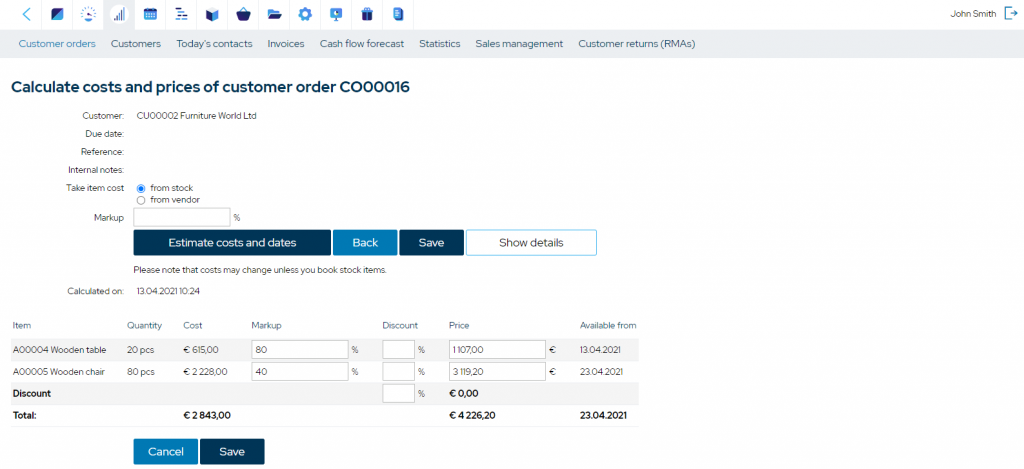Lead Time – Definitions, Tips, and Tools for Manufacturers
What is lead time and how to measure it? How to reduce your lead times and be more dependable? Here is a comprehensive guide to a topic that directly affects how happy your customers are.

You can also listen to this article:
What is Lead Time?
Lead time is the time it takes to fulfill an order from the moment it is confirmed until the order is delivered in full. In the manufacturing industry, companies mostly deal with three types of lead times:
- Material Lead Time is the time it takes for suppliers to deliver ordered goods to the manufacturer.
- Production Lead Time is the time it takes from submitting a manufacturing order up until the finished product is received into stock.
- Customer Lead Time is the time it takes for the company to produce the goods and/or deliver them to their customers, i.e. from order until fulfillment.
Customer lead time is approached differently in Make-to-Stock (MTS) and Make-to-Order (MTO) production modes. In MTO, production lead time signifies the expected time frame from customer order through production until delivery. In MTS, however, customer orders are fulfilled from stock, which is then replenished with another manufacturing order. Make-to-Stock lead times are therefore much shorter than those of Make-to-Order companies.
Another term is Cumulative Lead Time, which is a combination of material lead time, production lead time, and customer lead time. It presumes that no materials are available in stock, i.e. everything needs to be ordered from suppliers. Therefore, it measures the time it takes from confirming a customer order, putting in a purchase order and receiving the materials needed, manufacturing the product, and delivering it to the customer.
Other time-based manufacturing metrics
Apart from lead times, there are many other time-related metrics that manufacturers might find useful to track. These include throughput time, cycle time, and takt time – and although they are often confused with lead time as well as with one another, these are all different indicators that describe different processes.
Throughput time is how long it takes to manufacture a product from start to finish. This KPI only measures the time a product spends in the production process, including the time spent on processing, inspection, moving, and queueing. Throughput time is similar to Production Lead Time, but does not account for the time between submitting a manufacturing order and the start of production, e.g. the process of moving materials from inventory to the shop floor.
Cycle time is how long it takes to complete a specific part of the production process, e.g. the painting of a table.
Takt time is the time the production processes should take at the current demand rate in order to ensure that products are finished on time and idle time is kept at a minimum.
Read more about Throughput Time and Cycle Time and Takt Time.
How to reduce your lead times?
It is in every manufacturer’s best interest to reduce their lead times. Quick service and timely deliveries create satisfied customers – easy as that. And by reducing any of the previously mentioned lead times and other time-based metrics, customer lead times get shorter. This is because customer lead times are directly impacted by all the others.
Reducing material lead times
Material lead times can be reduced by properly qualifying your suppliers based on your needs and consistently evaluating their performance. If delivery speed is important to you, here are some tips:
- Prefer local suppliers to foreign ones. This is a no-brainer. Along with closer proximity and quicker delivery speed, you literally speak the same language with a local supplier, which helps avoid communication errors.
- Order smaller quantities more frequently. Instead of placing large bulk orders, spread the requirements out over a period. Even if this would mean higher transportation fees, the improved cash flow brought about by being able to fulfill orders quicker might very well weigh it up.
- Communicate with your suppliers. Share your sales forecasts with them so they could better anticipate orders. Create incentives for early deliveries. Share the results of their performance assessments to help them improve their service.
- Use procurement software. Using dedicated software for managing procurement allows you to prevent stock-outs and to make sure that hiccups in the supply chain are kept at a minimum. The best kinds of systems tie together your material requirements planning and your communications with suppliers.
Read more about Procurement Management.
Improving your internal processes
Improving your company’s internal processes and communication will boost productivity and most probably cut a chunk off your usual lead times. Internal processes that affect lead times are:
- Order processing. The amount of time your company spends on processing customer orders, manufacturing orders, and purchase orders has a direct impact on your lead times. Especially in the case of paper-based ordering with several control mechanisms, order processing could make lead times substantially longer than they need to be.
- Production planning and scheduling. Proper planning and timing are everything. Not knowing whether materials or workers are available is a surefire way to cause schedule overlapping, bottlenecks, stock-outs, production downtime, and ultimately, deadline extensions and longer lead times. Conversely, having a tight grip over what and when needs to happen will allow you to promise shorter lead times to customers and deliver on those promises.
Read more about Production Planning and Production Scheduling. - Inventory management. Confusion in the stockroom could be damning to a company by creating dead, expired, and obsolete stock, hiking up holding and labor costs, and increasing search time. Proper inventory management tools and techniques, however, will allow you to optimize your warehouse processes. Keeping your inventory neatly and logically organized will improve picking time and get the necessary materials to the production floor and finished goods to dispatch more quickly.
Read more about Warehouse Organization and Inventory Management.
Implement a manufacturing ERP system to automate many order-related processes, to precisely plan and schedule production, and to have a better overview of your customer orders, your material requirements, suppliers, and inventory levels.
How to provide customers with accurate lead times?
Notifying a client about a delivery being late is always a dreadful task. When late deliveries become the norm, however, you have got a problem on your hands. It is so easy to fall into the comfort of saying that being late for a couple of days is not a big deal. But when you turn the situation around and think about the inconveniences you experience when your suppliers are late, you will most certainly think differently.
Due dates are there for a reason. In the manufacturing and distributing business, everything revolves around materials and products – and when those are not where they should be when they should be, business breaks down. That is why giving accurate lead times to your customers is absolutely essential. If your clients know they can depend on accurate deliveries when planning out their business, they will most probably stay with you and recommend you to others as well.
The best way to give accurate lead times is to use an ERP system that has integrated modules for customer relationship management, production planning, procurement, and inventory management. All of the data pertaining to these departments is centralized within an ERP system. Thanks to the information regarding inventory levels, material requirements, production schedules, and supplier lead times, the software can accurately estimate due dates for customer orders.

Key takeaways
- Lead time is the time it takes to fulfill an order from order confirmation until delivery.
- Manufacturing companies usually measure Material Lead Times, Production Lead Times, and Customer Lead Times, sometimes also Cumulative Lead Times.
- Material Lead Time is the estimated time it takes for a company’s suppliers to fulfill Purchase Orders.
- Production Lead Time is the estimated time it takes to finish a Manufacturing Order.
- Customer Lead Time is the estimated time it takes to fulfill a Customer Order.
- Cumulative Lead Time is the estimated time it takes to confirm a CO, put in a PO for the materials and wait for them to arrive, produce the goods, and deliver them to the customer.
- Manufacturers also track other time-based metrics such as throughput time, cycle time, and takt time.
- Customer Lead Times can be reduced both by improving your procurement practices and supplier performance as well as by streamlining internal processes such as order processing, production planning and scheduling, and inventory management.
- An ERP system is essential in order to ensure better communication internally and externally: between departments, with suppliers, and with your customers.
You may also like: How to Calculate the Selling Price of Your Products?




